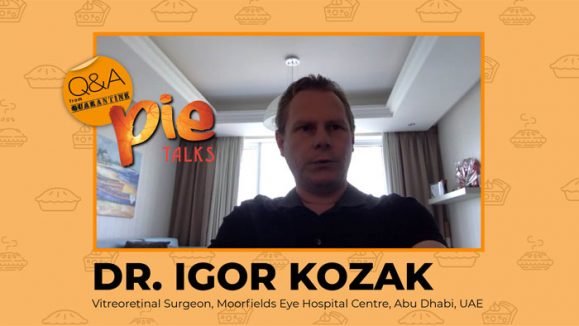At this point, nearly everyone is feeling the pandemic’s effects in some form or another. Families have lost loved ones, many have lost jobs, and uncertainty seems to lurk around every corner.
In ophthalmology, clinics and hospitals have been shuttered, except for emergencies. As a result, some patients may experience vision loss due to delayed treatment.
Dr. Paisan Ruamviboonsuk, former president of the Royal College of Ophthalmologists of Thailand and assistant director of the Centre of Medical Excellence at Rajavithi Hospital, in Bangkok, Thailand, is witnessing this first-hand. He’s recently returned to the clinic and is seeing patients again. Dr. Ruamviboonsuk shared details from one case: “I saw a patient yesterday who had received more than 40 anti-VEGF injections at this point. Recently, we’ve been able to extend his injections to every eight to 10 weeks — however, any longer than that, and a small amount of subretinal fluid would return.”
The patient’s last injections were in early February; he was due for his next treatment in mid-April. “Somehow, the appointment was postponed due to the pandemic,” he continued. “Now, about 12 weeks after the last injection, there is a tremendous amount of subretinal fluid.
“The patient was injected yesterday, but we need to see him again in four weeks, instead of 10 weeks like the last time,” said Dr. Ruamviboonsuk, adding that he expects to see more cases like this in the next few months.
Guidelines Aim to Preserve Sight and Safety
For patients with neovascular (or wet) age-related macular degeneration (nAMD), maintaining a regimen of intravitreal anti-VEGF injections is crucial to slowing the progression of the disease. Currently, there is no cut-and-dry regimen: Injections can be given monthly, every two or three months (extended-fixed), or as needed (pro re nata, PRN). More recently treat-and-extend (T&E) is being used, where treatment intervals are extended as long as there are no signs of disease progression.1
However, in the midst of the pandemic, expert organizations and physicians have come together to set treatment guidelines for these patients. The Vision Academy, supported by Bayer, is an international group of retina physicians working together to provide recommendations where the literature is inconclusive. Together, they have devised a set of anti-VEGF guidelines2 for ophthalmologists to follow, noting that the “practicality and risk–benefit of a treatment approach should be carefully considered to minimize patient exposure and preserve sight.”
For example, they recommend that patients with nAMD (especially those in the first two years of treatment) should be a priority, and their treatment schedules should be maintained. On the other hand, patients with diabetic macular edema (DME) or branch retinal vein occlusion (BRVO) are less likely to permanently lose sight and could be postponed.
Similarly, the Royal College of Ophthalmologists (RCOphth) have also announced guidelines for nAMD patients. Specifically, those patients should maintain anti-VEGF therapy every eight weeks with no clinic review, unless there is a significant drop in vision. They recommend DME patients postpone anti-VEGF injections and review in the clinic after four months.
The Vision Academy also recommends fixed dosing schedules or T&E over PRN approaches at this time: “Under normal circumstances, T&E regimens are highly beneficial to reduce the number of intravitreal injections a patient requires. However, with PRN the additional monitoring appointments that this regimen often requires may make it unsuitable during this unprecedented time, where there is a need to limit patient exposure and free up resources . . . therefore, fixed dosing intervals with reduced monitoring should be considered.”
Changing Tides of Treatment
Certainly, the coronavirus has disrupted . . . well, everything. But it’s also offered an opportunity for reflection and improvement.
Dr. Rafiq Hasan, vice president and global head of ophthalmology at Bayer (Basel, Switzerland) said that there has been greater interest in T&E over the past two years . . . and he expects that to be the case as we move out of the pandemic. Treat-and-extend has been favored by some ophthalmologists for its benefits of fewer patient visits and fewer injections while maintaining visual outcomes.
“I think, over time, certain countries are moving toward the treat-and-extend approach, but as we come out of this pandemic episode, there will be even greater emphasis on that,” explained Dr. Hasan.
“There is a difference of opinion about what treat-and-extend means . . . for example, what criteria do you use to extend intervals,” continued Dr. Hasan. “Some level of consistency and consensus around how you do that I think would be helpful. As we come out of this, I think our desire to protect our patients and minimize the number of injections, while optimizing the outcome, will be important.”
Dr. Hasan explained that the T&E approach has evolved over time, and was generated through both randomized control trials and real-world experience. “As we know, real world evidence is becoming more and more of an important issue in our environment, as we all accept that randomized control trials are very important but also have some limitations.”
Drive-Through Injections
As each country wages its own battle with the coronavirus, people around the world are in different stages of lockdown: Some areas are in total lockdown, some are lowering restrictive measures, and in some places things are nearly back to normal. When each country or region returns to a semblance of normalcy will differ, but the patients’ need for treatment will not, unfortunately.
Therefore, it’s important to find new ways of monitoring and treating patients. Dr. Hasan has one impressive example of this: A drive-in anti-VEGF clinic in Southampton, U.K. There, the patients are driven to the door of the clinic where they have a health assessment (checking temperature and for coronavirus symptoms). “If they are okay, they will walk into the clinic and into the injection suite; after the injection, they walk back to the car,” shared Dr. Hasan.
“With these types of solutions, they are making sure that the patient gets treated — along with minimizing the time in the [clinic],” he said, adding that he expects to see more innovations like this in the future.
He also relayed the importance of remote monitoring and assessment for patients with nAMD or diabetic eye disease. “[This] will become more important to minimize the time spent in clinics and hospitals . . . and it also minimizes the risk.”
The Vision Academy also recommends using telemedicine where appropriate, specifically to monitor patients who are at less risk of irreversible vision loss — but with the caveat that it should not extend beyond up to 4 months,
One positive of being forced inside and online is that it’s spurred innovation by leaps and bounds. “We have been getting feedback that historically, health systems have been very slow to innovate because of processes and other issues — but at this time of crisis, suddenly the speed of innovation has really increased,” said Dr. Hasan.
“We need to be ready in case there is a second wave or a future virus. The lessons learned from this experience will be very valuable . . . the guidelines in place and how to deal with future pandemics — and we will get even better at measuring these types of situations.”
Editor’s Note: This story is part of the new ‘Q&A from Quarantine’ series of PIE Talks, where Matt Young (CEO of Media MICE and Publisher of PIE and CAKE magazines), during the time of COVID-19 lockdown, reached out to KOLs and industry friends to evaluate and discuss the impact of this pandemic to the ophthalmic world.
References
- Li E, Donati S, Lindsley KB, et al. Treatment regimens for administration of anti-vascular endothelial growth factor agents for neovascular age-related macular degeneration. Cochrane Database Syst Rev. 2020;5:CD012208.
- Korobelnik J, Loewenstein A, Eldem B, et al. Guidance for anti-VEGF intravitreal injections during the COVID-19 pandemic. Graefes Arch Clin Exp Ophthalmol. 2020;23: 1–8.



